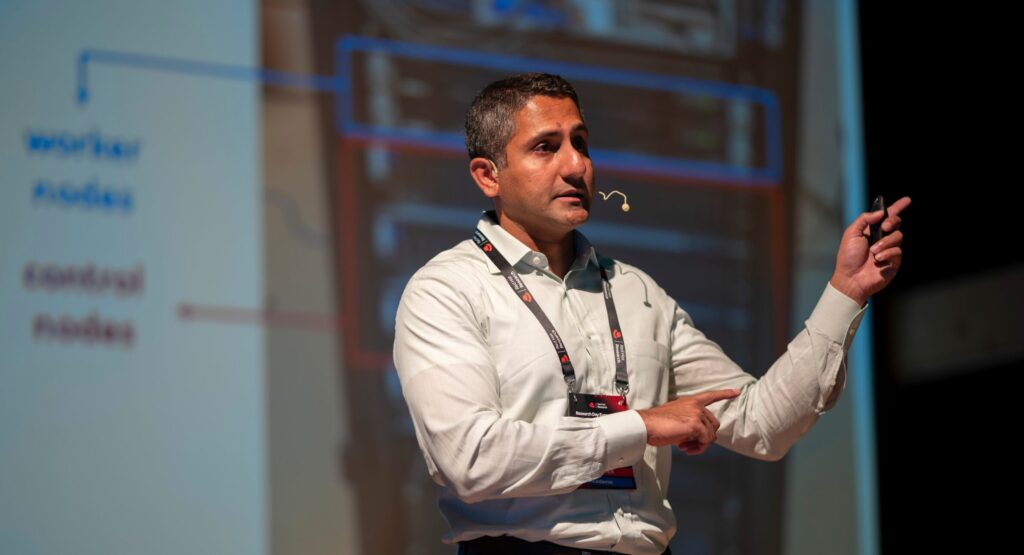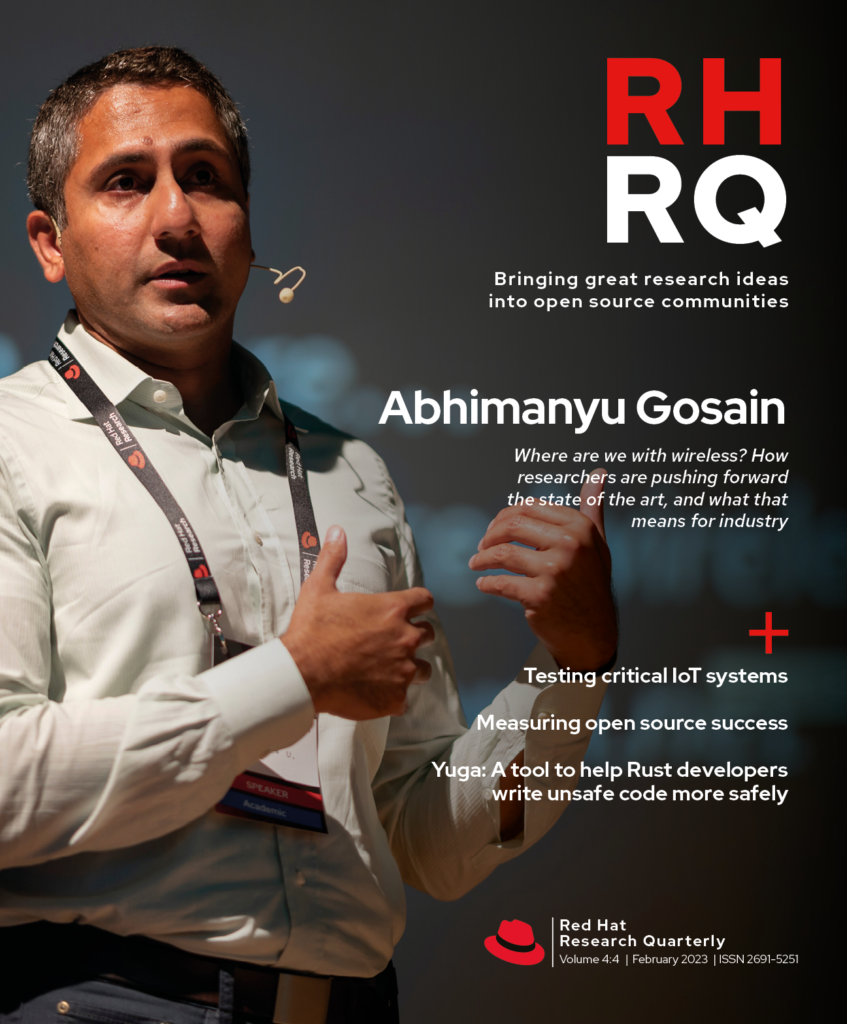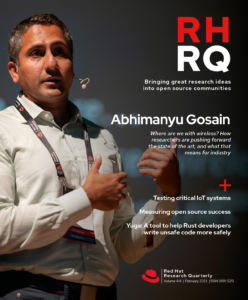
Red Hat Research Quarterly
Where are we with wireless? How researchers are pushing forward the state of the art, and what that means for industry
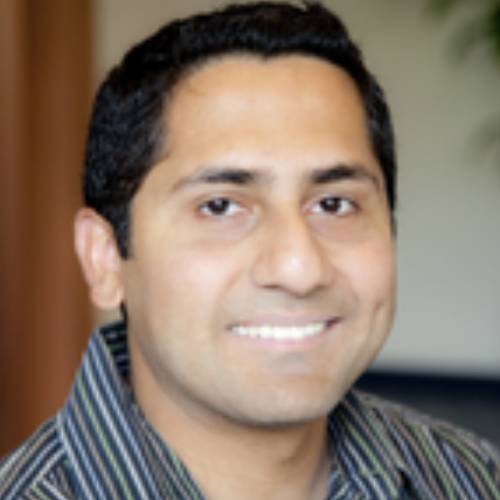
Article featured in
Abhimanyu (Manu) Gosain is a Senior Director for the Institute of the Wireless Internet of Things at Northeastern University, co-chair for the FCC 6G Technology Advisory Council and Senior Advisor for the National Telecommunications and Information Administration (US Department of Commerce), and the Office of the Undersecretary of Defense (US Department of Defense). Manu spoke with Heidi Dempsey, US Research Director for Red Hat, about how university research fits in the technology innovation cycle and the paradigm shifts that will shape the next generation of wireless protocols.
Heidi Dempsey: So you’re a wireless computing expert. You’ve done papers and given talks. You’re on government advisory committees and leading extensive research programs that are international and national in scope. What got you interested in computing and wireless to start?
Abhimanyu Gosain: Dialup was my first foray into networking and the internet. Your phone made that weird sound and opened a window to the world. The journey from me sitting 12,000 miles away in New Delhi, India, to where I am today wouldn’t have been possible if we weren’t connected by global networks. This obviously predates Zoom and online platforms, but that was still a huge part of being able to come to the US.
I got a small graduate assistantship helping a principal investigator who had embarked on the almost impossible mission of building a community wireless network that could be used for academic research. There were lots of learnings and growth and setting lots of single-board PCs on fire—
Heidi Dempsey: Literally?
Abhimanyu Gosain: Yes, literally! I was weatherizing and hardening systems, then working on all the software around making things communicate. I could implement what we’d learned in the books—like Shannon’s information theory and the Fourier transform—then actually see those things use the wireless channel. That got me hooked.
Heidi Dempsey: Just to clarify for our younger readers: When you talk about dialup, you’re talking about a time before you were even in university. So do you think you were always a nerd, or did you become a nerd because of dialup?
Abhimanyu Gosain: Ha! I think “became” would be the operative term. I was into soccer and breaking every windowpane in my neighborhood. My parents were a little more relaxed once I got hooked on computers because I could cause less damage. I did run up a long bill doing some online gaming, and they approached me with the four-figure bill. That’s how charging worked back in the day—unlimited data wasn’t a thing. As economies of scale have grown, we’re down to negative average revenue per user for our networks, which is a challenge. Back in the day, the cost was borne by the customers. Now, infrastructure providers bear that cost.
Heidi Dempsey: That’s especially true for wireless, where the cost is the device and the subscription, but there’s a huge amount of infrastructure behind that, making it all possible.
I ask about your past because one of the really interesting things about your job is that you have to talk to government people. You have to talk about policy, but you also need to have excellent nerd cred and be able to talk about the details of hardware and software. How does that work?
Abhimanyu Gosain: Over the past five years, during my transition from being a pure technologist to supporting federal agencies, regulatory agencies, and different consortiums and boards, I’ve learned that the most important thing is identifying the problem you are trying to solve. Instead of selling a solution or telling people how cool the technology is, I try to listen. Whether I’m talking to a Department of Defense person from a warfighter perspective or an operations perspective, they’re going to share their challenges.
Instead of selling a solution or telling people how cool the technology is, I try to listen.
I’ll take a very simple example: spectrum management. The year is 2022, and believe it or not, the most advanced army services in the world still manage the spectrum on Excel spreadsheets and sticky notes. On average, a spectrum management officer is staring at seven different screens because seven different isolated systems are operating at any given time. To absorb that amount of information and then render the intelligence or the data upstream to your commanders or stakeholders as a human-based decision—it’s a huge bottleneck. Now I understand the problem, and it’s not just a hypothesis or an algorithm I’m trying to develop.
That’s what we bring to our students at Northeastern University. Co-op programs allow for hands-on experience at the graduate and undergraduate levels to deal with real problems. And the philosophy we have at the Institute for the Wireless Internet of Things is to solve real-world problems and do it at a system level. We’re basing everything on very strong fundamental science, then taking the next step to build prototypes or reference platforms or architectures. That’s where we lean on the open source community a lot.
Heidi Dempsey: That’s really cool! That’s what we’re doing in Red Hat Research collaborations with Northeastern and other universities: let students take what they learn in the classroom and read in books and work with people hands-on in a real project. But I hadn’t thought about expanding that past the engineering world to include thinking about spectrums and thinking about policy. The same approach can help even though the domain is different.
Testbeds let network research guide the direction of industry
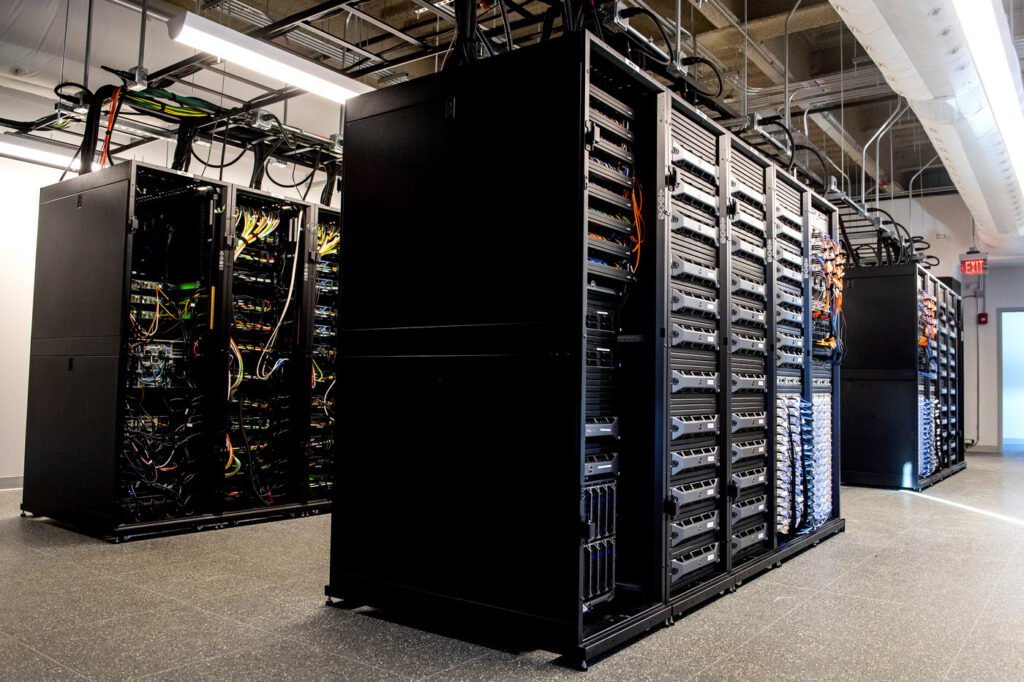
Heidi Dempsey: You’re the czar of many testbeds that have lots of amazing capacities. One of the places we’re using Red Hat OpenShift is in those testbeds. How does that tie into the challenge of finding a problem and solving it?
Abhimanyu Gosain: Look at what’s happened with cloud computing over the last decade in terms of software and programmability. This new paradigm was developed and accelerated in the context of a living lab—essentially, a testbed. We’ve capitalized on those advancements in wireless research. Yes, we sacrifice performance, but our goal is not necessarily to have something operational or production-ready. That will be done by industry.
The testbed allows us to develop our technology at the pre-standardization curve. That’s very different from where cloud orchestration networking companies are. Standardization and intellectual property are the biggest boon and curse in developing new wireless technology. We work through standard-development organizations like 3GPP [Third-Generation Partnership Project], which develops standards for wireless communications. If you enter a technology just a little bit late, you’re going to run up against the problem of intellectual property: industry ends up in different silos and doesn’t want to share ideas.
When we work at the pre-standardization, pre-commercial side of the technology, we can find and leverage large numbers of partners who are competitors with each other, but they all come to us with a common root-cause problem. The testbed can be the neutral environment that allows you to get fundamentals right. We can have a basis of agreement, for example, on where some additional performance enhancements happen if you use a MIMO [mutiple in multiple out antenna] system, which allows you to use the spectrum more efficiently. Then companies can add proprietary customizations on top: your custom schedules, algorithms, hardware optimization, acceleration. Companies will do what they each do best, but before that, research has made a measurable difference in the state of technology.
By the way, while we’re doing all this, students and research staff are getting those learnings at the same time as industry. For the 5G and 6G generation going forward, that’s going to be a massive paradigm shift. In the 2G, 3G, 4G days, university research lagged industry by at least 24 to 36 months. Industry didn’t come to us, because we weren’t at the cutting edge.
Standardization and intellectual property are the biggest boon and curse in developing new wireless technology.
Heidi Dempsey: And in the early days you were trying to do it with hardware, setting up wireless testbeds that could be six miles wide or with drones flying around. That’s a lot harder. You’re not doing that now, right?
Abhimanyu Gosain: We’re not doing that because the cloud’s moving closer and closer to the edge. As that journey continues, software will be the dominant factor. Then we’re going to see different forms of programmable compute—general purpose, GPUs, and FPGAs—and that’s what allows us, our students, and our cohort of research partners to build stuff and even accelerate certain research innovations before industry gets there.
Heidi Dempsey: So software is eating the wireless world, too, not just the cloud world?
Abhimanyu Gosain: For better and worse. It’s a new shift: with my training from 10 or 15 years ago, I wouldn’t survive in that world today. That’s why workforce development and training for students is a big issue. From a DevOps perspective or a system integration perspective in the telco world, at AT&T or Verizon or any CSP, they need a cloud engineer more than a hardware RF [radio frequency] engineer, and that’s huge. For example, platforms like OpenShift are what you need if you’re going to operate cloud container platforms and cloud paradigms and you’re going to run network functions that serve a purpose in the wireless domain. Still, the operation, the execution, the security, the resiliency, and so on, all have to be done by a cloud professional.
Heidi Dempsey: So we have Kubernetes in the cloud, which is an example of what you were saying about different models eventually converging on one standard. Is something like that coming for how the edge and cloud will connect?
Abhimanyu Gosain: Right now, the edge is the biggest area of research, innovation, and focus—both from industry and academia. It boils down to two questions. From an application or enterprise use case perspective, how can you provide access to or make sense of data coming from user devices and do it in a very small time cycle? And from a security/privacy perspective, how do you keep that data on-prem?
Heidi Dempsey: Wait—on-prem and wireless? You just blew my mind. What does that mean?
Abhimanyu Gosain: Take an enterprise case. Let’s say it’s industry 4.0: a factory where you have UAVs [uncrewed aerial vehicles] or robots working, or you have video streams where you’re tracking what’s going on. You don’t want to move that data, but you want the ability to make decisions based on ingesting those data streams. And you have to do that at a fidelity and timescale that doesn’t allow you to send that data into the cloud and back.
So you need some smartness, data preprocessing, or algorithm development implemented at the edge. At the enterprise level, you need visibility into that edge cluster. That’s the data optimization perspective—the data security, privacy, decision-making, closed-loop piece. From a DevOps perspective, that’s when you lean on the cloud a bit more.
In wireless, as with any network communication protocol, there’s a control plane, a user plane, and a management plane. The user and the control planes are where those data operations have to be done as locally as possible. That also has ramifications on costs and on how much energy you’re using. A lot of companies now understand that if we have a smart enough strategy on edge, we can move the needle again in terms of cost and performance, as well as experience.
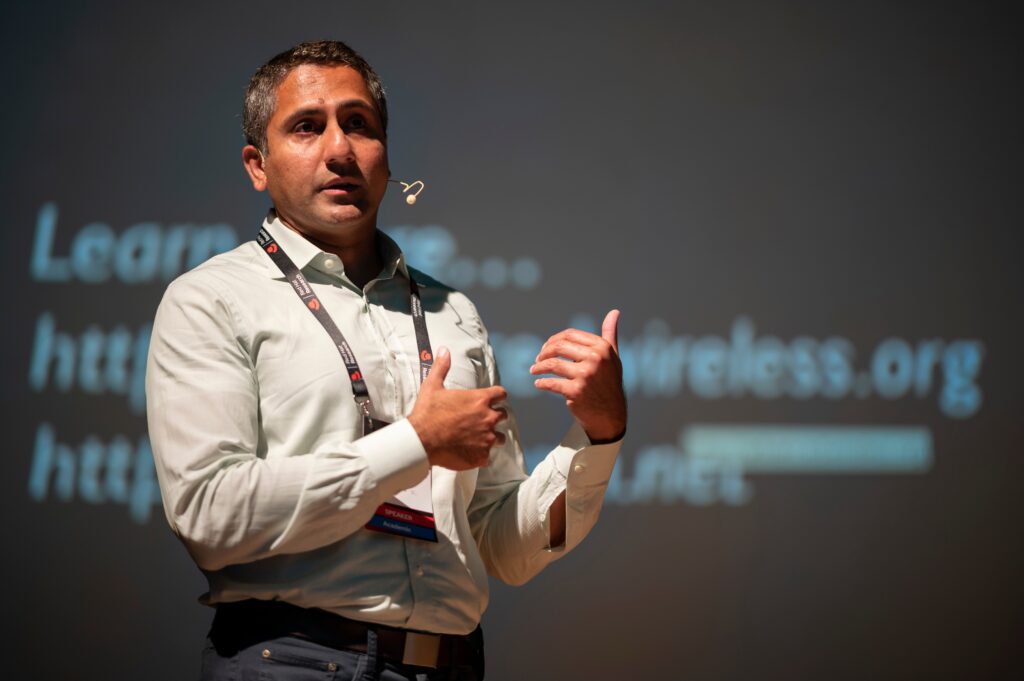
Heidi Dempsey: I see now why you use the term edge and don’t think so much about “wireless versus cloud.” We’re getting a lot of different clouds in a lot of different places that are rubbing up against each other, and we’re trying to abstract as much as we can what’s happening at the lower layers.
I was going to ask you why a cloud engineer should care about 5G versus 6G versus O-RAN [Open Radio Access Networks], but you already answered that. How much do you think they need to know? They can’t be oblivious to wireless protocols and how they affect what you can do, but—
Abhimanyu Gosain: They can, actually! You mentioned a magic term getting a lot of attention in industry and government circles: O-RAN. We’re now talking about abstracting away the key functionalities, like the wireless protocols, the wireless channel state information, and so on. Instead, we present it to you as an SDK with APIs, which is what you as a cloud engineer understand. For you, it’s a socket at most.
Then you have the RIC, or RAN Intelligent Controller, which is not too different from an SDN controller. It abstracts the functionality of your RAN equipment, or radio, or what in 5G speak is called gNodeB, with all the murkiness of wireless, from channel state information to IQ samples to physical resource blocks, which is something you’ll need—but you’d need to take a communications course to understand all those terms that I just used.
The beauty is that now the standard interfaces industry is developing abstract that information and present it to you as APIs that you can query and develop your own xApps or rApps, to use ORAN speak. Think of it as a closed-loop control system: AI and ML at each layer allow you to ingest data streams, absorb them, and then actuate or make a decision—either an optimization decision or an objective you want to meet. Then the tool will put that action back into the system, let the system behave, and report that back to you. If it needs to happen on the scale of milliseconds, that’s an xApp. If you can tolerate latency up to a second, that’s an rApp.
So now a cloud engineer or anybody with a basic understanding of computer engineering can begin to wade into the waters of wireless communications. We have the infrastructure, the radios, and the cool technology, but for you to utilize that, you just come to us with the programmatic mindset, maybe learn Python, and then you have the ability to query APIs and modify network parameters at your fingertips. And the reactions are near real time, so you can see those changes implemented.
Now a cloud engineer or anybody with a basic understanding of computer engineering can begin to wade into the waters of wireless communications
All of these network functions on a 5G architecture can be expressed or deployed as network functions on cloud orchestration platforms. At that point, the problem you face is the problem that you live with every single day, which is just workload management.
Expanding education and democratizing access
Heidi Dempsey: You’ve been in wireless for a long time, so I know you spend time up on roofs of buildings. You must have a good antenna story.
Abhimanyu Gosain: I’ll give you one funny story and one cautionary tale. The moral of the cautionary tale is to always monitor the weather before you go up on rooftops, especially in Cambridge, and be aware of the lake effect. Unobstructed 20-, 30-, 40-mph gusts feel very different when you’re standing on a 3m x 3m platform, holding on for dear life.
The funny story is how we ran afoul of the US Federal Communications Commission (FCC). The FCC dictates which wireless spectrum can be used, how it can be used, what power levels you can use it at, and so on. It’s very serious business: billions of dollars are at stake, and you don’t want to mess with public safety services or a CSP’s ability to provide them.
A misconfigured parameter in one of our RAN files set one of our radios to radiate at a frequency used by a communication service provider, who then filed an exception request with the FCC complaining of a rogue transmitter. This led to the FCC sending out regulatory engineers with spectrum analyzers, pointing at different rooftops, and identifying us as the culprit. That was an awkward interaction.
This led to training courses for everybody and putting safeguards and checks in place. So now if you are applying for an FCC experimental program license and you see certain additional requirements, you have us to thank for that.
Heidi Dempsey: It’s good to know that you have such a significant impact on government!
Abhimanyu Gosain: The FCC is very supportive of research, however. They want to allow wireless innovation to flourish.
Heidi Dempsey: Given that research and innovation are awesome, which we both believe, what advice would you give to people in university now or even before university who are computing on their own or playing around in AWS?
Abhimanyu Gosain: It’s easy to say that you should get hands-on experience. There’s nothing like trying to configure a server or a network interface. But I’m also cognizant that my worldview is shaped by sitting here at an R1 [top-tier US research] institution in the Northeast Corridor that is very well-resourced.
I co-chair the FCC Technology Advisory Council on 6G, and we hear from many people in rural America, where they’re still struggling to get 4G service. They laugh when we tell them we’re now looking at 6G.
We hear from many people in rural America, where they’re still struggling to get 4G service
Heidi Dempsey: That’s really important. We see the same thing. If you’re trying to reach out beyond the R1 level, it’s a bigger hurdle to get people over. Doing workforce training and apprenticeships is a lot harder if you’re thinking about how to do them in a research context
Abhimanyu Gosain: Growing that skilled workforce needs to start by teaching these concepts very early. Now we’re slowly seeing Chromebooks and laptops given to third- and fourth-grade students, and that resource stays with them until they get out of high school. If you have the basic resources, the choices are endless. There are free online tutorials from places like MIT’s OpenCourseWare. Covid has been a great equalizer because it has allowed people to access information that historically has been shared only at premier conferences where you have to pay thousands of dollars to attend. But now information is much more freely available. So there are no excuses at this point, if you have some semblance of resources or support.
Heidi Dempsey: Do you think the other direction is true too? For those of us who are already in the field, there are no excuses for not reaching out to people who don’t have all that advantage, right?
Abhimanyu Gosain: Absolutely. I’ll tie this back to one of the first questions you asked about working with government and working in technology. We’re trying to solve a problem. I think sometimes in our field we’re so focused on small bits and optimizing this, that, and the other that we forget the actual problem we’re trying to solve.
I think we are on the precipice of actually democratizing access. Thanks to federal support and cabinet-level positions for science and technology, I think we’re going to slowly start to fold in those who’ve been underserved and underrepresented for a while.
Heidi Dempsey: That’s really inspiring! And it’s a nice place to leave things. Thank you for taking the time to share your insights.
SHARE THIS ARTICLE
More like this
Václav Matyáš, Professor with the Centre for Research on Cryptography and Security at the Faculty of Informatics at Masaryk University.
Sanjay Arora is a data scientist at Red Hat and a member of the Greater Boston Research Interest Group with particular interests in AI and machine learning. For RHRQ he interviewed Kate Saenko, a faculty member at Boston University and consulting professor for the MIT-IBM Watson AI Lab, about managing bias in machine learning datasets and the problems that remain unsolved.
We spoke about the importance of data sharing and privacy preservation, in both scientific and computer technology domains, with James Honaker and Mercè Crosas, two of Harvard’s leaders in these fields.
Research Director and RIG leader for Israel Idan Levi speaks with Anat Bremler-Barr, Professor in the School of Computer Science and Vice Dean of the Efi Arazi School of Computer Science at the Interdisciplinary Center, Herzliya, Israel (IDC).
We invited Red Hat Principal Kernel Engineer Toke Høiland-Jørgensen to interview Anna Brunström, currently a Full Professor and Research Manager for the Distributed Systems and Communications Research Group at Karlstad University, Sweden. Prof. Brunström has a background in distributed systems, but her main area of work over the last years has been in computer networking. Their wide-ranging conversation covers programmable networking, open data, diversity in IT fields, and more.
Red Hat Research University Program Manager Matej Hrušovský interviewed Barbora Buhnová, Associate Professor and Vice Dean for industrial partners at Masaryk University, Faculty of Informatics in Brno, Czech Republic. She is also the chair of the Association of Industrial Partners of Masaryk University, Faculty of Informatics, and is a co-founding and governing board member of […]
Dr. Michael Zink is Professor of Electrical and Computer Engineering at the University of Massachusetts, Amherst. In addition to publishing and teaching, Dr. Zink has participated in several projects providing distributed systems and virtual networks for research and education, including GENI and ExoGENI (2007-2021), Cloud Lab (2014-2021), and now the Open Cloud Testbed (OCT) since […]
RHRQ asked Professor Ayse Coskun of the Electrical and Computer Engineering Department at Boston University to sit down for an interview with Red Hatter Marcel Hild. Professor Coskun is one of the Principal Investigators on the project AI for Cloud Ops, which recently won a $1 million Red Hat Collaboratory Research Incubation Award. Their conversation […]
RHRQ asked Brno research manager Matej Hrušovský and Red Hat quality assurance engineer Pavel Tišnovský to talk with long-time collaborator Tomáš Černý, a native of the Czech Republic now teaching at Baylor University in Waco, Texas. Prof. Černý was in Brno recently as part of his highly successful student research initiative, which brings Baylor students […]
